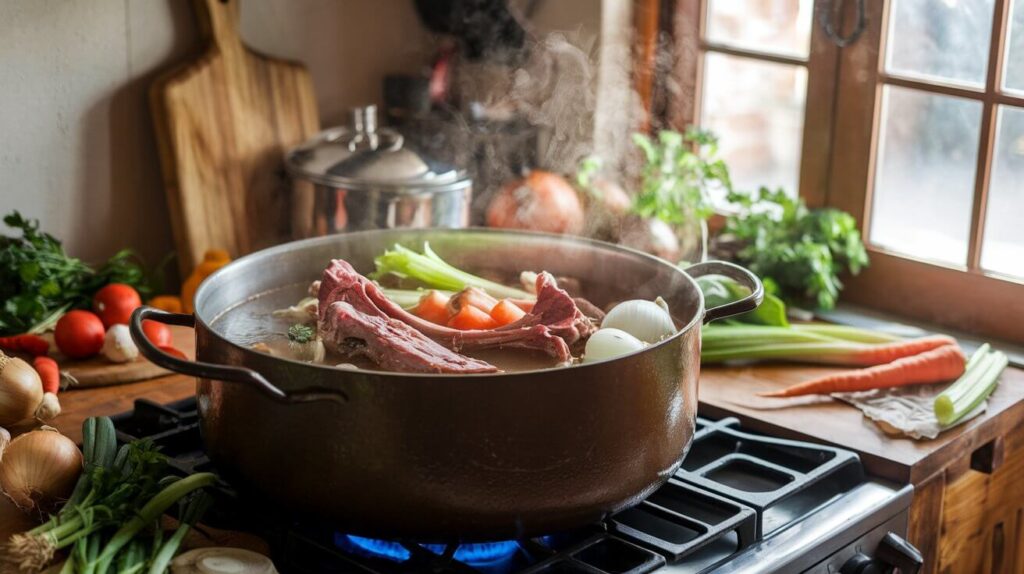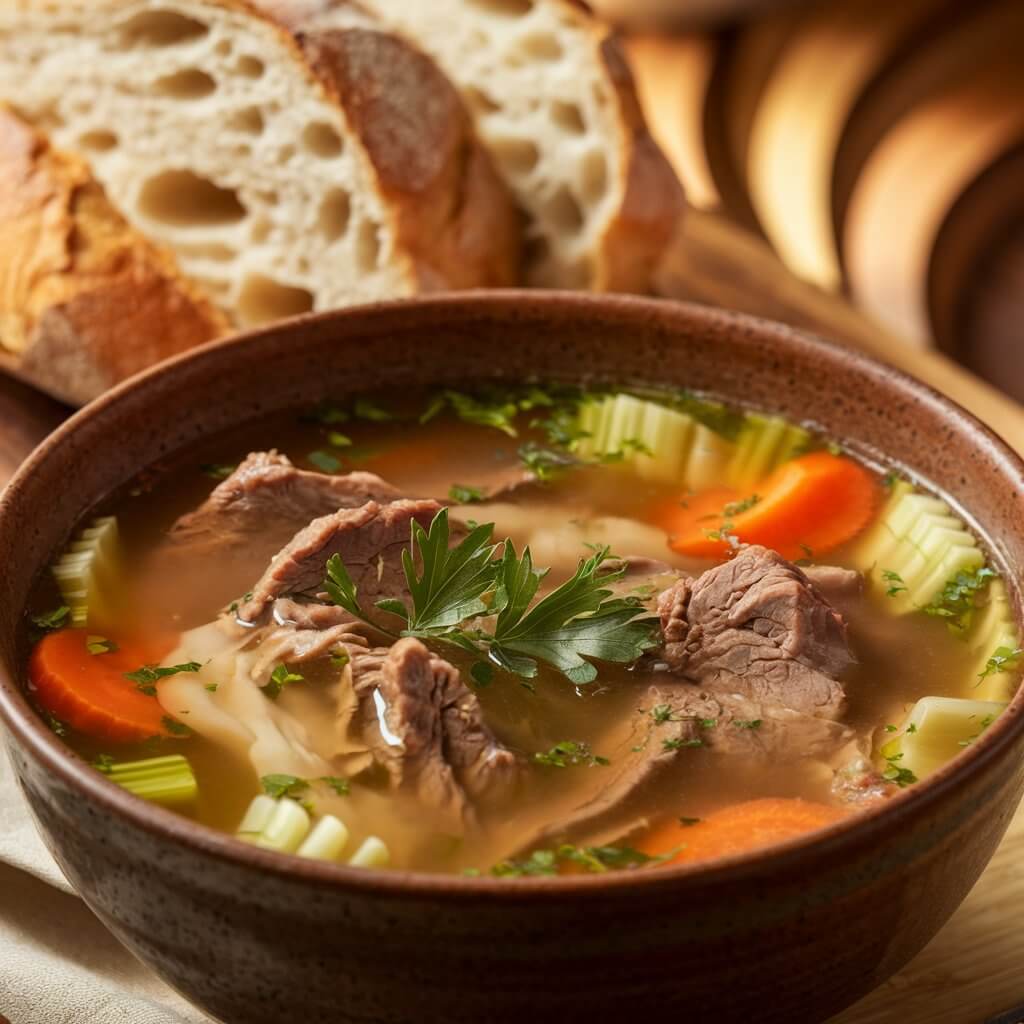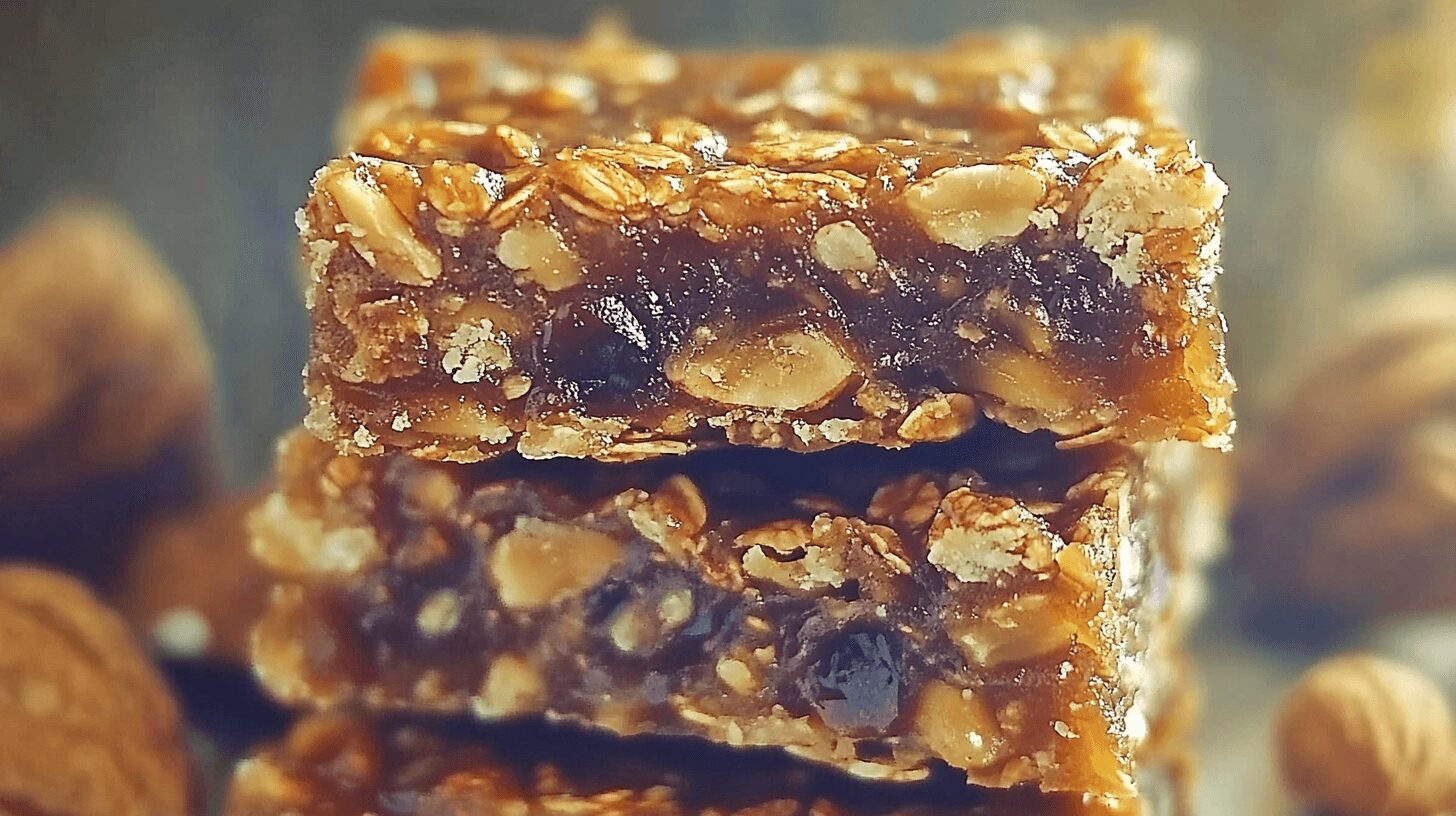Introduction
When creating a flavorful and nutrient-packed broth, beef soup bones are a must-have ingredient. But what is beef soup bones exactly? They’re often overlooked but are essential for making soups rich in taste and texture. Packed with collagen, marrow, and minerals, beef soup bones provide the base for countless culinary creations. From beef bone soup to classic bone broth, these bones are versatile and affordable, making them a favorite for home cooks and chefs alike.
In addition, this article will explore what beef soup bones are, their culinary uses, where to find them, and how to make the most of their flavors. Moreover, you’ll also find creative tips, variations, and answers to frequently asked questions to ensure your next beef soup or broth is a resounding success.
What Are Beef Soup Bones?
Beef soup bones are bones obtained from cattle, commonly used in soups and broths. They serve as a versatile and flavorful foundation for a wide variety of dishes, from hearty soups to nutrient-rich broths. For instance, these bones may include:
Types of Beef Soup Bones
- Marrow Bones: These bones are rich in fat and nutrients, adding a creamy texture to broths and soups. Marrow bones are highly sought after for their ability to create a rich and luxurious stock that enhances the flavor of any dish.
- Knuckle Bones: Packed with collagen, these bones are perfect for creating gelatinous broths. The high collagen content contributes to a thick, silky texture, making them ideal for dishes like ramen and stews.
- Neck Bones: Often meaty, neck bones provide a robust flavor that is perfect for slow-cooked recipes. They add depth and richness to broths, making them a popular choice among chefs.
- Shank Bones: Known for their marrow and the surrounding meat, shank bones are versatile and add both flavor and texture to soups and stews. Their unique composition makes them a favorite for creating hearty, nutrient-packed meals.
How Beef Soup Bones Are Used
In addition, these bones are simmered for extended periods, releasing their flavors and nutrients into the broth. The slow cooking process extracts minerals, collagen, and marrow, resulting in a rich and nutritious liquid base. For example, beef soup bones can be used in classic recipes like French onion soup, Vietnamese pho, or even as a base for gravies and sauces. “what is beef soup bones?”
Benefits of Beef Soup Bones
Beef soup bones are more than just an ingredient; they are a nutritional powerhouse and a flavor enhancer that can transform your cooking. Let’s explore their numerous benefits:
Rich in Nutrients
Beef soup bones provide essential minerals like calcium, magnesium, and phosphorus, which are vital for maintaining strong bones and overall health. These nutrients are slowly released into the broth during cooking, making it a highly nutritious addition to your diet. In addition, they contain trace elements like zinc and iron, which support immune function and energy levels.
High in Collagen
Collagen is a key protein found in beef soup bones, known for its ability to improve skin elasticity, joint health, and gut lining. When simmered, the collagen breaks down into gelatin, which helps repair tissues and promotes a healthy digestive system. As a result, consuming broth made from these bones can support a youthful appearance and joint mobility.
Flavor Enhancer
The marrow and meat remnants clinging to beef soup bones contribute to their deep, savory flavor. For instance, the marrow imparts a rich, buttery taste, while the slow cooking process intensifies the overall flavor profile of your broth. This makes it an excellent base for soups, stews, and sauces that require robust, complex tastes.
Budget-Friendly
In addition, beef soup bones are an economical choice for enhancing your cooking. They are often more affordable than cuts of meat, yet they provide immense value by elevating the taste and nutritional content of your dishes. Above all, they allow you to make the most of every part of the animal, aligning with sustainable cooking practices.
Versatile
Beef soup bones are incredibly versatile and can be used in a wide variety of dishes. For example:
- Soups: Create comforting classics like beef noodle soup or hearty vegetable beef soup.
- Gravies and Sauces: Use the broth as a flavorful base for rich sauces and gravies.
- Stews: Add depth and richness to slow-cooked dishes.
- Bone Broth: Sip on nutrient-dense bone broth as a health-boosting beverage.
In conclusion, these benefits make beef soup bones a must-have for every kitchen. Not only do they enhance the flavor and nutrition of your meals, but they also provide a sustainable and economical option for home cooking. “what is beef soup bones”

Where to Buy Beef Soup Bones “what is beef soup bones”
Finding beef soup bones is easier than you might think. Moreover, there are numerous places to purchase them, ensuring you can find the right type for your culinary needs. Below are some of the best options:
Local Butcher Shops
Local butcher shops are often the best source for high-quality soup bones. For example, butchers can provide specific types, such as marrow, knuckle, or shank bones, based on your preferences. In addition, many butchers are willing to cut the bones to your desired size, making them ideal for customized recipes. Visiting a butcher shop also allows you to ask questions and ensure you’re getting fresh, high-grade bones.
Grocery Stores
Many grocery stores carry soup bones in the meat section, often labeled as “soup bones” or “beef bones.” In addition, some stores may stock frozen soup bones, so it’s worth checking the freezer section if they’re not readily visible. For instance, major supermarket chains often have a dedicated section for cooking essentials like these, making them accessible for most shoppers.
Online Stores
Specialty meat suppliers and online grocers are excellent sources for beef soup bones. For example, many online platforms offer organic or grass-fed options, allowing you to prioritize quality and sustainability. Similarly, these suppliers often have a wide variety of bone types, from marrow to knuckle bones, ensuring you can find exactly what you need. In addition, shopping online provides convenience, with delivery options that save time and effort.
Farmers Markets
Farmers markets are another great place to buy beef soup bones. Local farmers often sell soup bones as part of their commitment to sustainable farming practices. For instance, purchasing directly from farmers supports local agriculture while ensuring freshness. On the other hand, availability may vary depending on the season and your location, so it’s a good idea to call ahead and confirm their stock.
Specialty Meat Shops
Specialty meat shops are dedicated to providing premium cuts and bones for cooking. These shops often carry unique options, such as smoked or seasoned bones, which can add an extra layer of flavor to your dishes. Moreover, the staff at specialty meat shops are usually knowledgeable and can offer tips on how to use the bones effectively.
Ethnic Grocery Stores
In addition, ethnic grocery stores often carry soup bones as part of their selection of traditional cooking ingredients. For example, Asian or Middle Eastern markets frequently stock knuckle and marrow bones used in cultural recipes. These stores can be a treasure trove for finding unique and flavorful options.
Tips for Choosing Beef Soup Bones
When buying beef soup bones, consider the following tips:
- Check for Freshness: Fresh bones should not have a strong odor or discoloration.
- Choose the Right Type: For example, marrow bones are ideal for rich broths, while knuckle bones add gelatin for thicker textures.
- Ask Questions: Don’t hesitate to ask about the source of the bones, especially if you prefer organic or grass-fed options.
- Plan Ahead: Some suppliers may require advance orders, so plan your purchase accordingly.
By exploring these options, you can easily find beef soup bones that meet your needs and elevate your cooking. “what is beef soup bones”
How to Use Beef Soup Bones in Cooking
Step-by-Step Guide to Making Beef Broth “what is beef soup bones”
- Prepare the Bones:
- Rinse the bones to remove impurities.
- Roast the bones in the oven at 400°F (200°C) for 30 minutes to enhance their flavor.
- Simmer the Bones:
- Add the roasted bones to a large pot.
- Cover with cold water and bring to a boil.
- Skim off any foam or impurities that rise to the surface.
- Add Aromatics:
- Include vegetables like carrots, celery, and onions.
- Add herbs and spices such as bay leaves, thyme, and peppercorns.
- Simmer for Hours:
- Reduce heat and simmer for 8-12 hours for maximum flavor.
- Add water as needed to keep the bones submerged.
- Strain and Store:
- Strain the broth through a fine-mesh sieve.
- Store in airtight containers in the refrigerator or freezer.
As a result, you’ll have a flavorful, nutrient-rich broth ready to use in various dishes. “what is beef soup bones”
Creative Variations
- Spiced Beef Bone Broth:
- Add ginger, star anise, and cinnamon for an Asian-inspired twist.
- Herb-Infused Broth:
- Incorporate fresh parsley, rosemary, and oregano for a Mediterranean flavor.
- Vegetable-Loaded Soup:
- Use the broth as a base for a hearty vegetable soup with potatoes, leeks, and kale.
- Beef Noodle Soup:
- Add cooked noodles and shredded beef for a comforting meal.
- Bone Broth for Dogs:
- Make a pet-friendly version without salt or onions to treat your furry friend.
In addition, these variations add versatility to your cooking repertoire. “what is beef soup bones”
Frequently Asked Questions (FAQs)
What Are Soup Bones Good For?
Soup bones are ideal for making broths, soups, and stews. Moreover, they add depth of flavor and provide health benefits like collagen and minerals. To learn more about soup bones, click here.
Are Beef Soup Bones the Same as Marrow Bones?
Not exactly. In contrast, marrow bones are a type of soup bone but are specifically valued for their rich marrow content. For further details, click here.
Can You Eat Beef Soup Bones?
While the bones themselves aren’t edible, the marrow and any meat clinging to them can be eaten. Consequently, they offer a flavorful addition to your dishes. To explore this topic, click here.
Are Beef Soup Bones Good for Dogs?
Yes, but only raw or properly cooked bones without seasoning. However, avoid cooked bones that can splinter. For more information on soup bones for pets, click here.
What Is the Best Bone for Soup?
Knuckle and marrow bones are the best for a gelatinous, flavorful broth. In fact, these bones are highly recommended by chefs. To know more about buying the best bones, click here.
Can You Get Soup Bones from a Butcher?
Absolutely. Butchers are a great source for fresh, high-quality soup bones. In addition, they may have options not available at grocery stores. If you’re looking for tips on where to buy soup bones, click here.
Conclusion
Beef soup bones are a powerhouse of flavor and nutrition, making them an essential ingredient in your kitchen. Above all, whether you’re crafting a classic beef broth or experimenting with creative twists, these bones provide a versatile and budget-friendly base for countless recipes.
In conclusion, now that you know what beef soup bones are and how to use them, it’s time to head to your local butcher or grocery store and start creating delicious soups and broths. Finally, beef soup bones truly do everything from enhancing your health to elevating your meals. ” what is beef soup bones?”

Chocolate Guinness Cake with Baileys Buttercream

Ultimate Dolly Parton Butterscotch Pie: 5 Sweet Reasons to Try This Classic Dessert

5-Minute Sausage Egg and Cheese Breakfast Roll-Ups: The Perfect Morning Delight

Healthy Avocado Grilled Cheese: 5 Reasons to Try This Nutritious Twist on a Classic

7 Reasons to Love Smothered Potatoes: A Delicious and Nutritious Comfort Food

Greek Yogurt Chia Pudding: 5 Reasons This Simple, Healthy Treat is a Game-Changer











